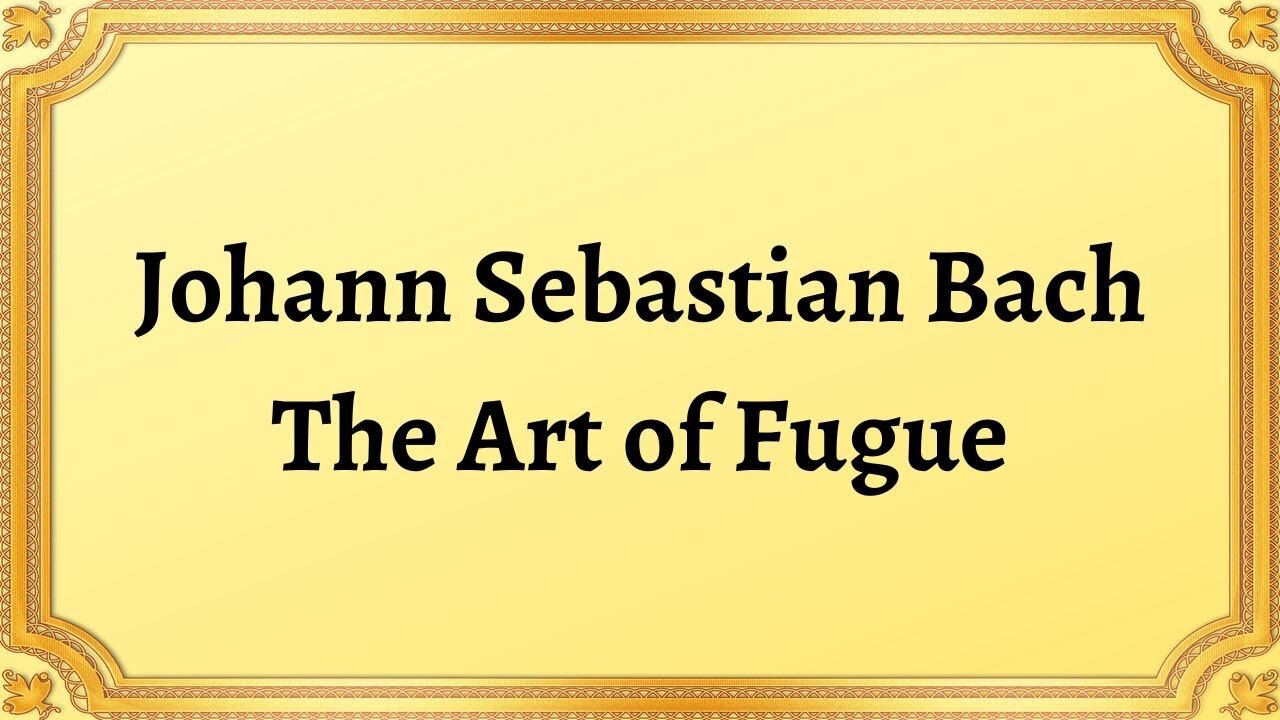Premium Only Content

Johann Sebastian Bach The Art of Fugue
#JohannSebastianBach
#TheArtofFugue
#Baroquemusic
#counterpoint
#polyphony
#fugue
#musicnarrative
#musicalcomposition
#musichistory
#creativity
Publication date 1950
Orchestre Radio Beromunster
Direction : HERMANN SCHERCHEN
1. The Art Of The Fugue - No 1
2. The Art Of The Fugue - No 2
3. The Art Of The Fugue - No 3
4. The Art Of The Fugue - No 4
5. The Art Of The Fugue - No 5
6. The Art Of The Fugue - No 6
7. The Art Of The Fugue - No 7
8. The Art Of The Fugue - No 8
9. The Art Of The Fugue - No 9
10. The Art Of The Fugue - No 10
Johann Sebastian Bach is a name synonymous with Baroque music, renowned for his contribution to the development of music during his lifetime. "The Art of Fugue" is one of his remarkable works in the musical genre and is considered one of the most significant contributions to Western classical music history. The piece is a collection of 14 fugues and four canons, and the score is entirely written in musical notation without any instrument or vocal arrangement specified.
Bach composed "The Art of Fugue" over the years of his life, working on it from 1740 up until the year of his death in 1750. The piece is a testament to Bach's mastery of the art of counterpoint, with each fugue showcasing the composer's skill in polyphonic music composition.
"The Art of Fugue" is notable for its structure and complexity. Bach created several versions of the piece, incorporating different voices and variations throughout time. The opening subject of the first fugue is prominent throughout the rest, demonstrating developments in composition and polyphonic music as the piece progresses.
The fugues are arranged in a specific order and form a musical narrative. As the piece moves from one fugue to another, it presents various musical styles, tonalities, and keys. Despite the complexity of the composition, each fugue is structured around a single focal point, the subject, which is passed on and developed in various ways.
Bach wrote "The Art of Fugue" as a testament to his life's work, and it remains an essential aspect of modern classical music. It demonstrates his unique composition style, which has inspired numerous generations of composers since the Baroque period. The use of complex polyphony, counterpoint, and variation techniques make "The Art of Fugue" a shining example of Bach's unparalleled creative genius.
Of course, the score of "The Art of Fugue" was not intended to be performed as a whole, and the composition of Bach does not specify the precise instruments to be used either, thus leading to various interpretations over time, ranging from performances on a pipe organ, harpsichord, and even orchestra.
In conclusion, Johann Sebastian Bach's "The Art of Fugue" is one of the most celebrated compositions in history. It is a testament to Bach's mastery of music composition and the use of complex polyphony and counterpoint. The piece has been hugely influential in the development of Western classical music and continues to inspire composers and musicians today.
You have the opportunity to support the channel https://destream.net/live/RadSiarAl/donate
-
 2:51:00
2:51:00
Fresh and Fit
4 hours agoAfter Hours w/ Girls
65.9K22 -
![[F EM UP Friday] Take # 2 [Destiny 2] Lets Kick Some A$$! #RumbleTakeOver](https://1a-1791.com/video/s8/1/c/W/7/1/cW71u.0kob-small-F-EM-UP-Friday-Take-2-Desti.jpg) LIVE
LIVE
CHiLi XDD
5 hours ago[F EM UP Friday] Take # 2 [Destiny 2] Lets Kick Some A$$! #RumbleTakeOver
1,717 watching -
 5:13:43
5:13:43
ItsMossy
11 hours agoHALO WITH THE RUMBLERS (: #RUMBLETAKEOVER
19.2K1 -
 1:54:08
1:54:08
INFILTRATION85
4 hours agoHi, I'm INFILTRATION
26.1K7 -
 LIVE
LIVE
GuardianRUBY
6 hours agoRumble Takeover! The Rumblings are strong
2,048 watching -
 4:28:45
4:28:45
Etheraeon
13 hours agoWorld of Warcraft: Classic | Fresh Level 1 Druid | 500 Follower Goal
34.5K -
 3:17:21
3:17:21
VapinGamers
5 hours ago $3.16 earned🎮🔥Scrollin’ and Trollin’: ESO Adventures Unleashed!
23.2K1 -
 LIVE
LIVE
a12cat34dog
7 hours agoGETTING AFTERMATH COMPLETED :: Call of Duty: Black Ops 6 :: ZOMBIES CAMO GRIND w/Bubba {18+}
184 watching -
 8:23:18
8:23:18
NubesALot
9 hours ago $4.41 earnedDark Souls Remastered and party games
22.4K -
 3:03:42
3:03:42
GamersErr0r
21 hours ago $1.89 earnedits not what you think
18.7K1